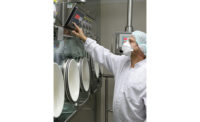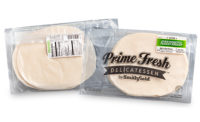Packaging Tech
The 'skinny' on sustainable meat packaging

Environmentally conscious consumers rule the day, and packaging is often the first element considered when making an eco-friendly purchase. Grocery shoppers are savvy enough to know which packages use fewer resources and energy than other packaging formats. With sustainability now a priority, consumer packaged goods (CPGs) companies expect their packaging equipment to push the limits of packaging materials, according to the 2017 PMMI State of the Industry U.S. Packaging Machinery Report, produced by PMMI, The Association for Packaging and Processing Technologies.
CPGs are spending more on packaging made of sustainable materials, including recycled corrugated cardboard, high-density polyethylene (rHDPE) and recycled polyethylene (rPET) film. With meat and other proteins, packaging solutions obviously must still protect the product despite taking on a thinner, less-intrusive profile. Sustainable lightweight materials, especially for flexible packaging, pose a protection challenge and add another barrier to shelf life and freshness.
As environmental pressures drive thinner film demand, downgauging continues to be a common driver in flexible plastic packaging even though many of these films are reaching their limits. With many films as lean as possible, costly high-performance films are increasing in importance, providing advantages such as less permeability and increased shelf life. Innovations such as oxygen scavengers and temperature indicators offer additional layers of solutions to improve the shelf life of meat, poultry and seafood. Because of this, 49 percent of companies polled in PMMI’s Trends Shaping Meat, Poultry and Seafood report indicate they are using both modified atmosphere packaging (MAP) and vacuum packaging for shelf-life extension. Thirty-six percent of respondents say they are using high-pressure processing (HPP) to improve freshness without added preservatives. Three out of five companies also seek improvements to film durability and temperature performance in addition to wrinkle-reduction and recyclability to keep their products fresh but while maintaining shelf appeal.
MAP extends the life of fresh or minimally processed foods such as meat and poultry with less environmental impact. It significantly reduces the amount of oxygen reaching meat sealed in flexible bags, delaying decomposition. The gases that remain — typically nitrogen and CO2 — do not react with or degrade food products, so contents stay fresher longer. An outgrowth of this technology, Equilibrium Modified Atmosphere Packaging (EMAP), contains a lowered level of oxygen and a higher proportion of CO2, which preserves fresh produce. Both EMAP and MAP packaging flush oxygen out of flexible packages with an injection of gas. Gas packaging technology employs different films, which in the case of inert products such as meat, poultry or seafood, acts as an airtight barrier against gases.
Packaging professionals in the meat, poultry and seafood sector will find the latest technologies and sustainable packaging innovations at PACK EXPO International 2018 and the co-located Healthcare Packaging EXPO (Oct. 14-17, 2018; McCormick Place, Chicago). At the show, more than 50,000 attendees will convene with more than 2,500 exhibitors. New this year, the PACKage Printing Pavilion (located in the South Building at McCormick Place) will offer an opportunity to see cutting-edge labeling innovations and techniques to improve shelf appeal. Returning show features including the Containers and Materials Pavilion (in the Upper North Building) and the Reusable Packaging Pavilion (in the Upper Lakeside Center) will display advancements in sustainable packaging that are new to the market. In addition to aisles of packaging solutions, packaging professionals will have access to free, on-floor educational sessions at three different Innovation Stage locations. To register and learn more, visit packexpointernational.com. NP
Looking for a reprint of this article?
From high-res PDFs to custom plaques, order your copy today!






